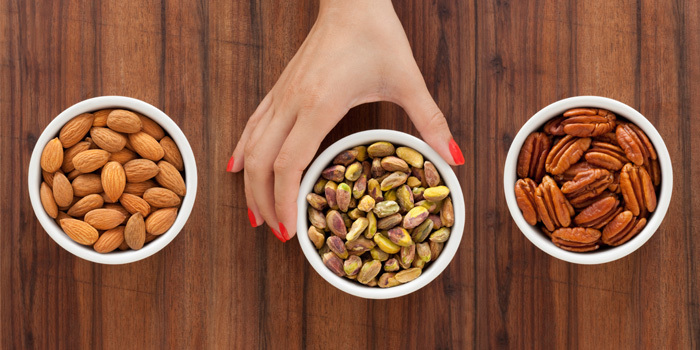6 Benefits of Eating Nuts
by Beachbody

In fact, nuts are so loaded with nutrients, they could be considered nature’s dietary supplement pill. Of course, roasted in heavy oil and salts, they become a lot less healthy but, properly consumed raw, or in some cases roasted (namely, chestnuts), nuts deliver a vast array of benefits unique to each.
Following are six overarching advantages to consuming nuts, within which are more specific nutrient benefits.
1. They Can Promote Heart Health and Circulation
Arginine
An amino acid produced by the body, arginine is implicated in healing, muscle growth, and sperm health because of its stimulation of protein production. But it’s perhaps known best for preventing arterial buildup by expanding blood vessels. Worth noting: Peanuts are not technically nuts, they’re legumes. Also, don’t eat them raw…or honey roasted. Opt for dry roasted, which are almost as healthy (but safer) as raw ones.
– Best source: Peanuts (1 g/1 oz serving – 166 calories, approx. 28 peanuts)
– Runners-up: Almonds (0.75 g), walnuts (0.7 g), hazelnuts/filberts (0.65 g – 178 calories, approx. 21 hazelnuts)
Omega 3
Omega 3s are polyunsaturated essential fatty acids, and walnuts contain the alpha-linolenic (ALA) form—over 150% of the Recommended Dietary Allowance (RDA), in fact. Benefits include decreased LDL (bad cholesterol) levels, increased HDL (good cholesterol) levels, and a possible reduced risk of heart attack.
– Best source: Walnuts (2.7 g/1 oz serving – 185 calories, approx. 14 walnut halves)
– Runners-up: Pecans (20% RDA), pistachios (5% RDA), macadamia nuts (4% RDA)
Iron
This mineral source is fundamental to the production of red blood cells, the delivery units of oxygen throughout the body. While recommended intakes for men (8 mg) and women (18 mg) vary, a handful of cashews delivers about 25% and 11% of the RDA, respectively.
– Best source: Cashews (2 mg/1 oz serving – 157 calories, approx. 17 cashews)
– Runners-up: Hazelnuts (1.4 mg), peanuts (1.4 mg), pistachios (1.3 mg)
2. They Can Help Preserve Brain and Mental Function
Folate
This B vitamin plays a key role in lowering homocysteine—an amino acid associated with conditions like heart disease, Alzheimer’s disease, and dementia. Low folate levels have also been linked to depression, anemia, and even hair loss.
– Best source: Peanuts (72 mcg or 18% RDA/1 oz serving)
– Runners-up: Hazelnuts (34 mcg/9% RDA), walnuts (29 mcg/7% RDA), pistachios (15 mcg/4% RDA)
Magnesium
Magnesium plays a role in more than 300 chemical reactions in the body, including proper digestion, heart and circulatory function, and bone growth and maintenance. It’s also been suggested as a viable aid in memory retention.
– Best source: Brazil nuts (113 mg or 28% RDA for men/1 oz serving – 186 calories, approx. 6 kernels)
– Runners-up: Cashews (88 mg), almonds (81 mg), peanuts (50 mg)
3. They Promote Vision and Eye Health
Vitamin A (Beta-carotene)
The nonanimal form of Vitamin A that gives plants their color is implicated in slowing macular degeneration, limiting sun sensitivity, and lowering the risk of heart disease. Pistachios are particularly rife with it, delivering 14% per serving.
– Best source: Pistachios (125 mcg or 14% RDA for men/1 oz serving – 159 calories, approx. 49 pistachios)
– Runners-up: Pecans (17 mcg), walnuts (6 mcg), hazelnuts (6 mcg)
Lutein and Zeaxanthin
These two antioxidants play an important role in reducing the risk of chronic eye diseases, including macular degeneration and cataracts by filtering harmful high-energy blue wavelengths of light.
– Best source: Pistachios (362 mcg/1 oz serving)
– Runners-up: That’s it. Pistachios are the only nut containing lutein and zeaxanthin in significant quantities.
4. They Help Regulate Weight and Metabolism
Protein
Nuts are a fantastic source of this vital energy for vegetarians—and anyone else. According to the Harvard School of Public Health, eating nuts instead of red meat once a day can lower the risk of type 2 diabetes 16 to 35%.
– Best source: Peanuts (7.8 g/1 oz serving)
– Runners-up: Almonds (6.3 g), pistachios (6 g), cashews (5.4 g)
Fiber
The fiber and sustained energy content of most nuts make them filling without being fattening, and chestnuts are by far the lowest in fat and calories than all other nuts.
– Best source: Chestnuts (1.5 g fiber, 39 calories/1 oz serving – 70 calories, approx. 3 chestnuts)
– Runners-up: Almonds (3.75 g fiber/174 calories), pistachios (3 g fiber/169 calories), peanuts (2.5 g fiber/170 calories)
Vitamin E
There are eight forms of this antioxidant, but the one found in nuts is of the alpha-tocopherol variety. Fairly strong evidence suggests it aids in preventing type 1 and 2 diabetes and treating fatty liver disease.
– Best source: Almonds (7.8 mg or 52% RDA/1 oz serving – 163 calories, approx. 23 almonds)
– Runners-up: Hazelnuts (4.5 mg/30% RDA), peanuts (2.5 mg/17% RDA), Brazil nuts (1.8 mg/12% RDA)
5. They Help Strength Bones and Teeth
Calcium
While also vital to blood and cellular function, 99% of all calcium in the body is found in bones and teeth, where it prevents osteoporosis and decay. Almonds are the nuts highest in this mineral, and number two isn’t really close.
– Best source: Almonds (81 mg or 8% RDA/1 oz serving)
– Runners-up: Brazil nuts (48 mg/5% RDA), hazelnuts (34 mg/3% RDA), pistachios (32 mg/3% RDA)
Phosphorus
The only mineral more prevalent in the body than phosphorus is calcium. Combined, the two work to grow, maintain, and repair bones and teeth, along with all other tissues and cells.
– Best source: Brazil nuts (218 mg or 31% RDA/1 oz serving)
– Runners-up: Cashews (178 mg/25% RDA), pistachios (147 mg/21% RDA), almonds (144 mg/21% RDA)
6. They Aid in Boosting Immunity
Zinc
The overall amount of this mineral found in the body is nominal, but it’s vital to immunity, affecting T cell and other immune cell functions and helping to stave off pathogens.
– Best source: Cashews (1.7 mg or 16% RDA for men/1 oz serving)
– Runners-up: Pecans (1.4 mg/13% RDA), Brazil nuts (1.2 mg/11% RDA), peanuts (1 mg/9% RDA)
Vitamin B6 (Pyridoxine)
Important for keeping hormones balanced and healthy, deficiency among the B6 compounds is associated with compromised immune response. One serving of pistachios contains 40% of the RDA for an average adult.
– Best source: Pistachios (0.51 mg/1 oz serving)
– Runners-up: Hazelnuts (13% RDA), walnuts (12% RDA), cashews (10% RDA)
Includes recipes, support, exercise suggestions, accounta bility partner and more! Most people lose weight and get back on track with healthy eating. Be sure to indicate you are interested in the next FREE "Back on Track" Challenge in the application. CLICK HERE to apply
bility partner and more! Most people lose weight and get back on track with healthy eating. Be sure to indicate you are interested in the next FREE "Back on Track" Challenge in the application. CLICK HERE to apply
